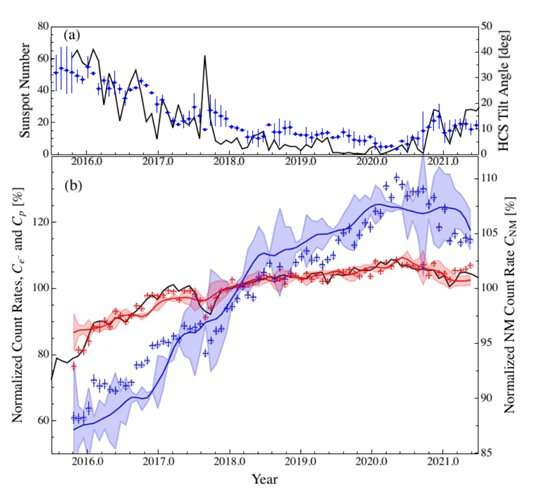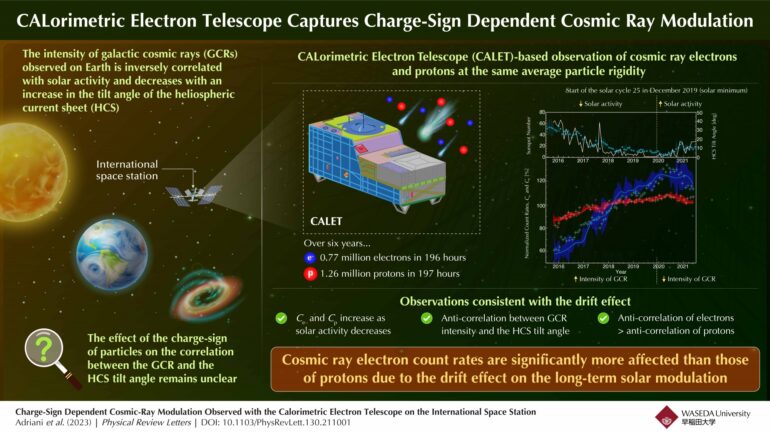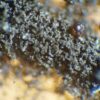The movement of cosmic ray particles across space, such as electrons and protons, is influenced by the sun’s magnetic field, causing fluctuations in the intensity of galactic cosmic rays (GCRs) reaching Earth in response to the solar cycle. During periods of low solar activity, such as the solar minimum, more GCRs have been observed to reach Earth compared to that for periods of high solar activity. This inverse correlation between the GCR-flux and solar activity is known as “solar modulation.”
Specifically, the intensity of GCRs on Earth is affected by the tilt angle of the heliospheric current sheet (HCS), a spiral surface separating the direction of oppositely directed magnetic field lines originating from the poles of the sun. As the tilt angle of the HCS increases, the intensity of cosmic rays on Earth decreases.
According to the drift model of GCR transport in the heliosphere, the negatively charged electrons in GCRs tend to travel along the HCS to reach Earth if the magnetic field is directed away from the sun in the northern hemisphere, and towards the sun in the southern hemisphere. In contrast, the positively charged protons reach Earth from the heliospheric polar region, suggesting that GCR electrons are more affected by solar modulation than the protons as they travel through the HCS to reach Earth.
While previous observations of cosmic ray particles made aboard space balloons and in space experiments show differences between the fluxes of positively and negatively charged GCR particles during the solar cycle, it is unclear whether the particle charge plays any role in the anticorrelation between GCR intensity and the tilt angle of the HCS.

The observations by CALorimetric Electron Telescope (CALET) reveal that the count rates of electrons (in blue) are more strongly influenced than that of protons (in red) with the changing tilt angle of the heliospheric current sheet. © Yosui Akaike from Waseda University, Japan
Now, in a recent observation of GCR charged particles made with the CALorimetric Electron Telescope (CALET) onboard the International Space Station’s “Kibo” Exposed Facility (EF) over a period of six years, researchers have revealed that this anticorrelation is, in fact, more prominent for electrons than for protons.
The study, published in Physical Review Letters, was co-led by three researchers from Japan, Associate Professor Yosui Akaike of the Waseda Research Institute for Science and Engineering (RISE) at Waseda University, Associate Professor Shoko Miyake of the National Institute of Technology (KOSEN) at Ibaraki College, and Professor Kazuoki Munakata of Shinshu University. It also included contributions from Professor Emeritus Shoji Torii from RISE.
“Using CALET, we successfully observed a charge-sign dependent solar modulation of GCRs over six years,” says Akaike.
The researchers analyzed over 0.77 million electrons and 1.26 million protons collected in about 196 and 197 hours, respectively, over a six-year period from 2015 to 2021, which coincided with the end of solar cycle 24 and the beginning of solar cycle 25, the current solar cycle.
The findings indicated that during the low activity state of the sun towards the end of solar cycle 24, characterized by a reduction in the number of sunspots and HCS tilt angle, both electron and proton count rates were low but gradually increasing. This trend continued with the onset of solar cycle 25, reaching its peak in electron count rate six months after the beginning of the cycle in December 2019.
Thereafter, both electron and proton count rates gradually decreased as the sun’s activity and HCS tilt angle increased. Furthermore, the results showed that the variation in the count rates of electrons was significantly higher than that of protons during this period, suggesting that electrons are more susceptible to the effects of solar modulation, as predicted by the drift model.
“This is a clear signature of the drift effect dominating the long-term solar modulation of GCRs observed with a single detector,” highlights Akaike.
Overall, analyzing GCRs can shed important light on the composition of the universe and the acceleration mechanisms of high-energy particles observed in cosmic rays. Thus, the observations made by CALET could help better understand the space weather and its effects on the possibility of potential life on the moon and other planets, like Mars.
More information:
O. Adriani et al, Charge-Sign Dependent Cosmic-Ray Modulation Observed with the Calorimetric Electron Telescope on the International Space Station, Physical Review Letters (2023). DOI: 10.1103/PhysRevLett.130.211001
Citation:
CALorimetric Electron Telescope (CALET) captures charge-sign dependent cosmic ray modulation (2023, June 8)



